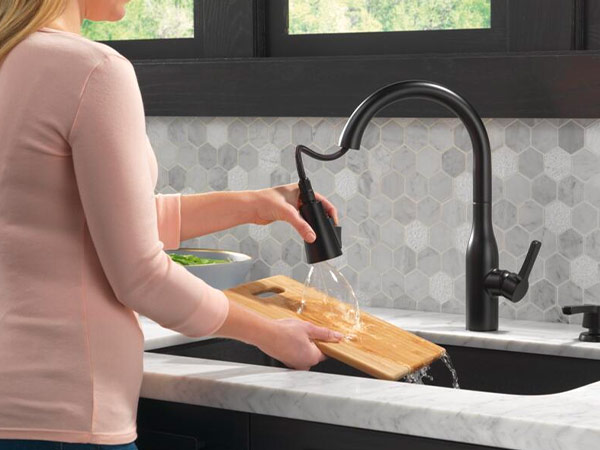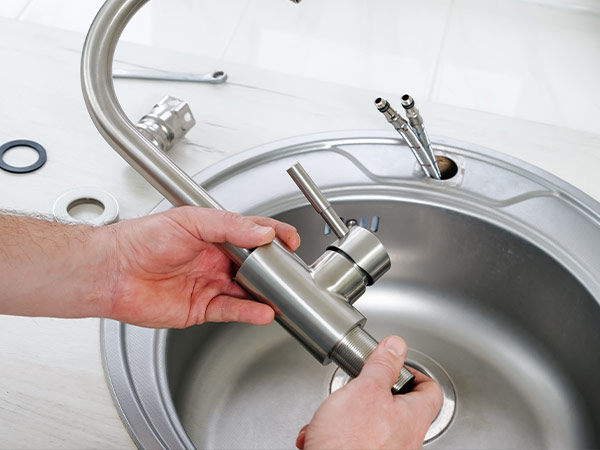

Types of Kitchen Faucets: Which is Best for Your Sink?
If you have remodeled “everything but the kitchen sink” in your home, it may be time to spruce that kitchen sink up with a new kitchen faucet. There are many types of kitchen faucets for you to choose from like a modern chrome pull-out model to a more traditional double-handled brass faucet. A new faucet can enhance the look of your entire kitchen and add some nice functionality too—especially when it comes to the dreaded chore—dish duty.
With so many sizes, shapes, and types of kitchen faucets, how do you know where to start? Before you make your purchase, let us help you determine what type of faucet best fits your needs. Tackling the installation yourself? We’ll give you a quick refresh of the parts of a kitchen faucet.

Types of Kitchen Faucets

There are many types of kitchen faucets that can meet your individual preferences. The first thing to consider is the size and shape of your sink. Your new faucet should fit and complement your existing sink, or your new sink if you’re upgrading both.
Also, consider the number and size of holes you already have when assessing the type of faucet you would like. Take into consideration the height of the faucet spout too. It should be tall enough to easily clean all your dishes, pots, and pans.
Flow rate is another factor to keep in mind when you are choosing a new faucet. According to the EPA, kitchen faucets use 19% of the water in most homes, so there are regulations as to how much pressure a faucet can have. Anything 1.5 above to 2.2 GPM (gallons per minute) is standard. Let’s look at the types of faucets to choose from.
- Pull-out faucets provide you with a full range of motion. If you are an avid cook with larger pots and pans, this is a great option, as you can fill pots easily without having to place them inside your sink. You can also clean large, deep sinks easily with the expanded reach.
- Single-handle faucets, also called single-hole faucets, have one handle to adjust the water temperature and flow. This provides ease of use and installation, as they only require one hole for installation.
- Double-handle faucets have just that: two handles. One is for hot and one for cold. These have a traditional look but do require more holes in your sink.
- Pull-down faucets have a pull sprayer connected to a hose that is angled downward to easily clean the sink or fill pots with water when cooking, but don't have the full range of motion like pull-out faucets.
- Sprayer faucets are a feature on some that allows you to press a button to switch from a stream of water to a stronger spray. This feature makes washing dishes go much faster.
- Side sprayer faucets have a separate sprayer, which requires another hole for mounting.
Some other Add-Ons
- Soap dispensers are included with many models of faucets. They have a separate dispenser for soap along with the faucets, so they will require a separate hole also.
- Drinking water dispenser faucets and filtration systems have a separate dispenser for water, even hot, along with the faucets, so they will require a separate hole.
Finishes of Kitchen Faucets
After choosing your faucet, pick a finish that matches your design.
- Aerator - This is the small mesh piece that attaches to the tip of the faucet which slows the water flow by splitting it into multiple smaller streams of water. This minimizes the flow and splash of water into the sink.
- Spout - This is the main part of a faucet that transfers the water from the water pipes to the sink. There are many designs for spouts including straight, gooseneck, shepherd’s crook, and an articulating spout which allows you to move the spout in many directions. Touchless spouts are also available, which are activated by a motion sensor. This and the handle combine to make a decorative statement.
- Handle - There are many options for single handles, which attach to the top or side of the faucet body and open and close the water valve. You can also have two handles mounted on either side of the spout as well.
- Valve - This regulates the temperature and flow of water. Many valves come in a cartridge form and can easily be ordered from the manufacturer when a replacement is needed. Other valves come in ceramic disks, ball faucets, and compression valves (in two-handle faucets).
- Body - This is the space where the hot water and cold water combine prior to flowing through the spout. It is attached to the mount on the sink.
- Mount - This attaches the faucet itself to the sink. Many faucets are mounted on the sink, yet some are attached to the wall, which provides a unique design element.


Installing a Kitchen Faucet
Installing a kitchen faucet is so straightforward and simple that we have to include basic steps, so you won’t let the installation of a new faucet deter you from purchasing a new one.
- Before you get started, shut off the water supply to the faucet by turning off both of the shut-off valves under the sink.
- Remove the existing faucet by unscrewing the nuts underneath your sink. (Tip: You can use a blow dryer to release nuts that have rusted.)
- To install a new faucet, apply plumber's putty between the sink if it’s a top mount sink or the counter If it’s an under-mount sink to create a seal.
- Wrap plumber’s tape on the new faucet threads where you will screw it down. If your new faucet comes with an O-ring as a part of its base, you don’t even need to apply putty.
- Seal the new sink holes with silicone sealant.
- Place the new faucet in the new hole or holes, and securely tighten the nuts. Apply firm pressure, but make sure the it’s not so tight that it damages the sink or countertop.
- Connect your water lines and start using your new kitchen faucet.
Drop by your local McCoy's, so we can help you compare the various types of kitchen faucets and decide which one best fits your sink. Plus, we have everything you need for installation. Once you have installed your stylish, new faucet that gives you true cleaning power and saves you time in the kitchen, you may find even more time to tackle another DIY project!
